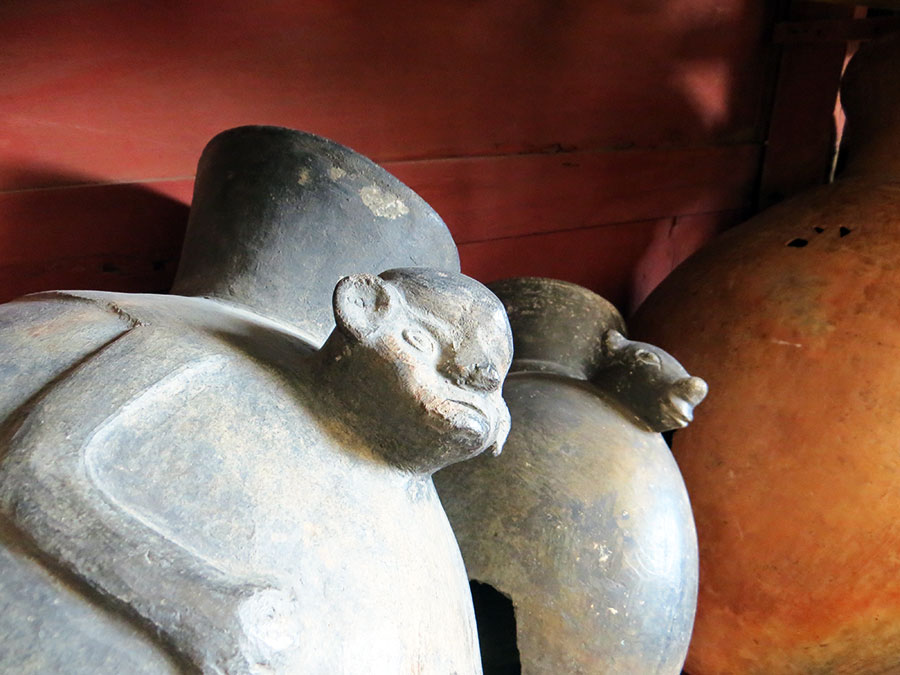The Central Andes: insights into the northernmost Inca expansions and the diffusion of Quechua languages
The diffusion of Quechua languages has traditionally been associated with the expansion of the Inca empire, or in some cases with the Spanish colonial regime and its promotion of Quechua as a language of evangelization. Archaeological and linguistic contexts, and early Spanish chronicles, have been interpreted to suggest an important role either for demographic spread or for cultural diffusion. This scenario can be tested with the help of molecular anthropology to reveal the magnitude of both the demographic expansion and the level of admixture with autochthonous populations.

The Quechua languages are the most widely spoken native language family of the Americas, and thus taken here as an ideal case-study for testing the correlations proposed between expansive processes in the historical, archaeological and linguistic records and actual population movements and admixture processes (see Heggarty and Beresford-Jones, 2012, and contributions therein, from many disciplines). One of the major transformations in the (pre)history of South America before European contact was the rise of the Inca empire, which extended as far south as central Chile and as far north as southern Colombia, until its rapid collapse during the Spanish conquest from 1532 (D’Altroy, 2014). The current diffusion of the Quechua mirrors in several cases – but only indirectly – the use of this language as a lingua franca through the empire. Major population movements fostered by the Inca state policy were probably influencing this language spread (Cerrón-Palomino, 1987; Adelaar and Muysken, 2004; Heggarty, 2008).
Did the Incas help spread Quechua varieties by moving people or by cultural assimilation – or by which complex mix of the two? Archaeological and linguistic disciplines provided partial explanation of this diffusion phenomenon, but they are not able to reliably provide a direct measure of demographic events: the magnitude of any population movements and expansion, and the level of genetic admixture with the autochthonous communities.

This project begins by looking at the northern extension of the Inca state, analyzing the diversity of regions where diverse varieties of Quechua are spoken over discontinuous territories, and cases of contact between Inca and pre-Inca societies. In this very region, a few varieties of Quechua of difficult classification are scattered in isolated enclaves and spoken by relatively small numbers of people.
The focus on the Central Andes, where the ancient cultures of Caral developed almost 5000 years ago, embraces the foundation of South American civilization. This region is studied as a cradle of maritime and Andean cultures, like Moche, Tiwanaku, Wari, Chimú and Chachapoya, which successions impacted the prehispanic population diversity until the Inca times. Knowledge of extant and extinct language maps, together with the rich archaeological background available, anchor the study of genetic relatedness between living and ancient groups.
For this project, I collected and analyzed genetic data from living populations and compared it with other populations and ancient DNA data. This genetic analysis, explicitly informed by the archaeological, historical and social contexts, compares against linguistic data, to shed light into the processes of language diffusion and diversification.
This project is developed with Dr. Paul Heggarty, expert of language diversity and prehistory of the Ands, and with the collaboration of Prof. Ricardo Fujita and Dr. José Sandoval of Universidad San Martin de Porres, Lima, and Matthias Urban from University of Tübingen.
FURTHER READING:
Urban M & Barbieri C. 2020. North and South in the ancient Central Andes: contextualizing the archaeological record with evidence from linguistics and molecular anthropology. Journal of Anthropological Archaeology 60, 101233 LINK
Nakatsuka N, Lazaridis I, Barbieri C, Skoglund P, Rohland N, Mallick S, Harkins-Kinkaid K, Ferry M, Harney E, Michel M, et al. 2020. A Paleogenomic Reconstruction of the Deep Population History of the Andes. Cell 181:1131-1145.e21. LINK
Barbieri C, Barquera R, Arias L, Sandoval JRJR, Acosta O, Zurita C, Aguilar-Campos A, Tito-Álvarez AM, Serrano-Osuna R, Gray R, Mafessoni F, Heggarty P, Shimizu KK, Fujita R, Stoneking M, Pugach I, Fehren-Schmitz L. 2019. The current genomic landscape of western South America: Andes, Amazonia and Pacific Coast. Mol Biol Evol. 36(12), 2698–2713. LINK
- Adelaar WFH, Muysken PC. 2004. The Languages of the Andes. Cambridge: Cambridge University Press.
- Cerrón-Palomino R. 1987. Lingüística Quechua. Cuzco, Peru: Bartolomé de Las Casas.
- D’Altroy TN. 2014. The Incas. John Wiley & Sons.
- Heggarty P. 2008. Linguistics for Archaeologists: a Case-study in the Andes. Cambridge Archaeol J 18:35–56.
- Heggarty P, Beresford-Jones D eds. 2012. Archaeology and Language in the Andes. Oxford: Oxford University Press.
